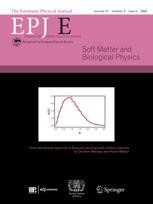Macroscopic and microscopic structures of clay-surfactant mixtures
As a tribute to the late colloid scientist Isabelle Grillo, two of her principal co-workers have published a summary of some of the ground-breaking work in her PhD thesis.
New York | Heidelberg, 28 October 2024
 The premature death of Isabelle Grillo (1972-2019), a distinguished colloid scientist at the Institut Laue-Langevin (ILL), Grenoble, France, left much of the work on clay-surfactant mixtures that she had presented in her PhD thesis still unpublished. This gap has now been filled by two of her former co-workers, Sylvain Prévost of ILL and Thomas Zemb of the Institut de Chimie Separative de Marcoule, Bagnols-sur-Cèze, who have published an extensive overview of this work and her legacy in EPJ E.
The premature death of Isabelle Grillo (1972-2019), a distinguished colloid scientist at the Institut Laue-Langevin (ILL), Grenoble, France, left much of the work on clay-surfactant mixtures that she had presented in her PhD thesis still unpublished. This gap has now been filled by two of her former co-workers, Sylvain Prévost of ILL and Thomas Zemb of the Institut de Chimie Separative de Marcoule, Bagnols-sur-Cèze, who have published an extensive overview of this work and her legacy in EPJ E.
Mixtures of clays and surfactants have many practical applications, including in cosmetics and pharmaceuticals and for environmental remediation. In her PhD research, Grillo used the related techniques of small-angle X-ray scattering and small-angle neutron scattering to probe the structures of these complex mixtures at the molecular or nanoscale, and to relate these to their everyday, macroscopic nature. These techniques produce information about the ‘average’ structure of the materials rather than the very local structures seen under an electron microscope.
Grillo investigated mixtures of a negatively charged clay with surfactants that were, respectively, positively charged, negatively charged and uncharged, under a range of osmotic pressures: that is, the pressures resulting from suspensions of tiny solid objects in a solution.
For each mixture, she produced a phase diagram that illustrated the types of structure that appeared under different conditions. Depending on these conditions, the clay particles could be inserted in surfactant bilayers, dispersed between them or excluded from a separate surfactant phase. She elegantly described the interplay between these phases as “a struggle for water [between the components...] as both clays and surfactants strive to be surrounded by water molecules”. Over the last quarter-century these techniques have been used to probe the structures of many other complex materials.
“Even 25 years later, Grillo’s PhD research is still cutting-edge and useful for many industrial applications”, concludes Prévost. “In publishing this overview, we honour her ability to unveil the extraordinary structures of ordinary things”.
Reference: Grillo, I., Prévost, S. & Zemb, T. Insertion of anionic synthetic clay in lamellar surfactant phases. Eur. Phys. J. E 47, 55 (2024). https://doi.org/10.1140/epje/s10189-024-00447-2
Further Information
For more information visit: www.epj.org
Services for Journalists
The full-text article is available here.
Contact
Sabine Lehr | Springer | Physics Editorial Department
tel +49-6221-487-8336 | sabine.lehr@springer.com
